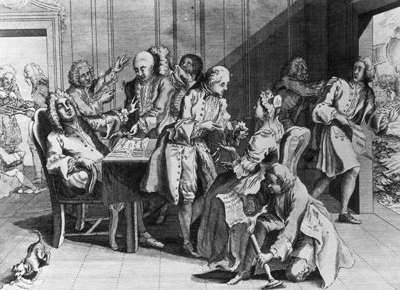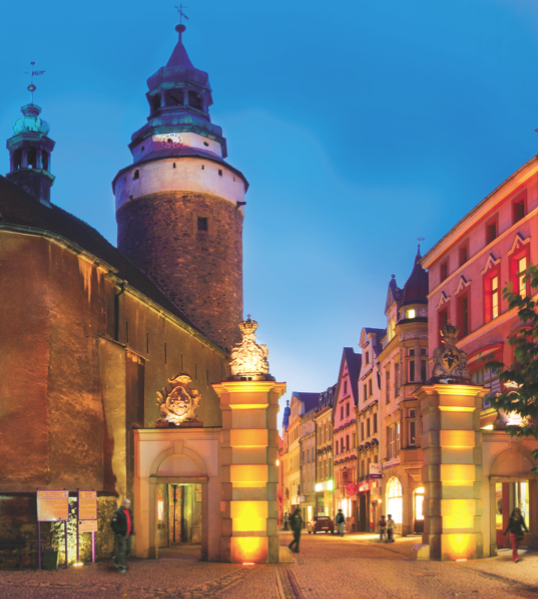|
Johann Georg Urbansky
Johann Georg(e) Urbansky (, ) (1675–1738) was a Bohemian-German baroque-era sculpture, sculptor and carver, who was mainly active in Lower Silesia. Life He was born in Chlumec (Ústí nad Labem District), Kulm (now Chlumec) in Northern Bohemia. In 1693 he became a student of the sculptor Jan Brokoff, Johann Brokoff in Prague. In 1697 he went to Bautzen to continue his apprenticeship with Theodor Pausewein. After 1718 he was active in Wrocław, Breslau (now Wrocław), working together with other sculptors like Johann Albrecht Siegwitz and Franz Joseph Mangoldt. Work (selection) * Wrocław, Breslau (now Wrocław) ** Wrocław Cathedral: *** Marble pulpit (1723, together with Johann Adam Karinger) *** Sculptures of the Saints Gregory and Hieronymus (1727) *** Epitaphs of the bishops Gottfried and Nanker (1723) ** St. Mary Magdalene Church, Wrocław, St. Mary Magdalene Church, Organ Case (1722–1724) ** Cathedral of St. Vincent and St. James, Wrocław, Cathedral of St. Vincent an ... [...More Info...] [...Related Items...] OR: [Wikipedia] [Google] [Baidu] |
Baroque
The Baroque ( , , ) is a Western Style (visual arts), style of Baroque architecture, architecture, Baroque music, music, Baroque dance, dance, Baroque painting, painting, Baroque sculpture, sculpture, poetry, and other arts that flourished from the early 17th century until the 1750s. It followed Renaissance art and Mannerism and preceded the Rococo (in the past often referred to as "late Baroque") and Neoclassicism, Neoclassical styles. It was encouraged by the Catholic Church as a means to counter the simplicity and austerity of Protestant architecture, art, and music, though Lutheran art#Baroque period, Lutheran Baroque art developed in parts of Europe as well. The Baroque style used contrast, movement, exuberant detail, deep color, grandeur, and surprise to achieve a sense of awe. The style began at the start of the 17th century in Rome, then spread rapidly to the rest of Italy, France, Spain, and Portugal, then to Austria, southern Germany, Poland and Russia. By the 1730s, i ... [...More Info...] [...Related Items...] OR: [Wikipedia] [Google] [Baidu] |
Collegiate Church Of The Holy Cross And St
Collegiate may refer to: * College * Webster's Dictionary, a dictionary with editions referred to as a "Collegiate" * ''Collegiate'' (1926 film), 1926 American silent film directed by Del Andrews * ''Collegiate'' (1936 film), 1936 American musical film directed by Ralph Murphy * "Collegiate" (song), song by Moe Jaffe and Nat Bonx See also * Collegiate athletics, athletic competition organized by colleges and universities * Collegiate church, a church where the daily office of worship is maintained by a college of canons * Collegiate School (other) * Collegiate institute, a Canadian school of secondary or higher education * Collegiate university * St Michael's Collegiate School, Hobart, Australia * Collegiate Gothic Collegiate Gothic is an architectural style subgenre of Gothic Revival architecture, popular in the late-19th and early-20th centuries for college and high school buildings in the United States and Canada, and to a certain extent Europ ..., an ... [...More Info...] [...Related Items...] OR: [Wikipedia] [Google] [Baidu] |
German Male Sculptors
German(s) may refer to: * Germany, the country of the Germans and German things **Germania (Roman era) * Germans, citizens of Germany, people of German ancestry, or native speakers of the German language ** For citizenship in Germany, see also German nationality law **Germanic peoples (Roman era) * German diaspora * German language * German cuisine, traditional foods of Germany People * German (given name) * German (surname) * Germán, a Spanish name Places * German (parish), Isle of Man * German, Albania, or Gërmej * German, Bulgaria * German, Iran * German, North Macedonia * German, New York, U.S. * Agios Germanos, Greece Other uses * German (mythology), a South Slavic mythological being * Germans (band), a Canadian rock band * "German" (song), a 2019 song by No Money Enterprise * ''The German'', a 2008 short film * "The Germans", an episode of ''Fawlty Towers'' * ''The German'', a nickname for Congolese rebel André Kisase Ngandu See also * Germanic (disambig ... [...More Info...] [...Related Items...] OR: [Wikipedia] [Google] [Baidu] |
18th-century German Male Artists
The 18th century lasted from 1 January 1701 (represented by the Roman numerals MDCCI) to 31 December 1800 (MDCCC). During the 18th century, elements of Enlightenment thinking culminated in the Atlantic Revolutions. Revolutions began to challenge the legitimacy of monarchical and aristocratic power structures. The Industrial Revolution began mid-century, leading to radical changes in human society and the environment. The European colonization of the Americas and other parts of the world intensified and associated mass migrations of people grew in size as part of the Age of Sail. During the century, slave trading expanded across the shores of the Atlantic Ocean, while declining in Russia and China. Western historians have occasionally defined the 18th century otherwise for the purposes of their work. For example, the "short" 18th century may be defined as 1715–1789, denoting the period of time between the death of Louis XIV of France and the start of the French Revolution ... [...More Info...] [...Related Items...] OR: [Wikipedia] [Google] [Baidu] |
17th-century German Sculptors
The 17th century lasted from January 1, 1601 (represented by the Roman numerals MDCI), to December 31, 1700 (MDCC). It falls into the early modern period of Europe and in that continent (whose impact on the world was increasing) was characterized by the Baroque cultural movement, the latter part of the Spanish Golden Age, the Dutch Golden Age, the French '' Grand Siècle'' dominated by Louis XIV, the Scientific Revolution, the world's first public company and megacorporation known as the Dutch East India Company, and according to some historians, the General Crisis. From the mid-17th century, European politics were increasingly dominated by the Kingdom of France of Louis XIV, where royal power was solidified domestically in the civil war of the Fronde. The semi-feudal territorial French nobility was weakened and subjugated to the power of an absolute monarchy through the reinvention of the Palace of Versailles from a hunting lodge to a gilded prison, in which a greatly expande ... [...More Info...] [...Related Items...] OR: [Wikipedia] [Google] [Baidu] |
1738 Deaths
Events January–March * January 1 – At least 664 African slaves drown when the Dutch West Indies Company slave ship ''Leusden'' capsizes and sinks in the Maroni River during its arrival in Surinam. The Dutch crew escapes, and leaves the slaves locked below decks to die. * January 3 – George Frideric Handel's opera '' Faramondo'' is given its first performance. * January 7 – After the Maratha Empire of India wins the Battle of Bhopal over the Jaipur State, Jaipur cedes the Malwa territory to the Maratha in a treaty signed at Doraha. * February 4 – Court Jew Joseph Süß Oppenheimer is executed in Württemberg. * February 11 – Jacques de Vaucanson stages the first demonstration of an early automaton, '' The Flute Player'' at the Hotel de Longueville in Paris, and continues to display it until March 30. * February 20 – The Swedish Levant Company is founded. * March 28 – Mariner Robert Jenkins presents a pickle ... [...More Info...] [...Related Items...] OR: [Wikipedia] [Google] [Baidu] |
1675 Births
Events January–March * January 5 – Franco-Dutch War – Battle of Turckheim: The French defeat Austria and Brandenburg. * January 29 – John Sassamon, an English-educated Native American Christian, dies at Assawampsett Pond, an event which will trigger a year-long war between the English American colonists of New England, and the Algonquian Native American tribes. * February 4 – The Italian opera '' La divisione del mondo'', by Giovanni Legrenzi, is performed for the first time, premiering in Venice at the Teatro San Luca. The new opera, telling the story of the "division of the world" after the battle between the Gods of Olympus and the Titans, becomes known for its elaborate and expensive sets, machinery, and special effects and is revived 325 years later in the year 2000. * February 6 – Nicolò Sagredo is elected as the new Doge of Venice and leader of the Venetian Republic, replacing Domenico II Contarini, who had died 10 d ... [...More Info...] [...Related Items...] OR: [Wikipedia] [Google] [Baidu] |
Tyniec Nad Ślęzą
Tyniec nad Ślęzą is a village in the Administrative District of Gmina Kobierzyce, within Wrocław County, Lower Silesian Voivodeship, in south-western Poland. It lies on the river Ślęza and approximately south of the regional capital Wrocław. Monuments * Gothic wayside shrine * Baroque statue of St. John of Nepomuk John of Nepomuk (or John Nepomucene) (; ; ) ( 1345 – 20 March 1393) was a saint of Bohemia (a western part of what is now the Czech Republic) who was drowned in the Vltava river at the behest of King Wenceslaus IV of Bohemia. Later accounts st ... , kapliczki-przydrozne.blogspot.com/ (in Polish) References [...More Info...] [...Related Items...] OR: [Wikipedia] [Google] [Baidu] |
Strzegom
Strzegom () is a town in Świdnica County, Lower Silesian Voivodeship, in south-western Poland. It is the seat of the Gmina Strzegom administrative district (gmina). It lies approximately north-west of Świdnica, and west of the regional capital Wrocław. As of 2019, the town had a population of 16,106. One of the oldest towns in Lower Silesia, with a settlement dating back to Ancient history, Antiquity, in the Middle Ages Strzegom became the seat of a castellan and a centre for clothmaking, linenmaking and brewing, and since the early modern period it became known for granite mining, to which it owes the title of the "capital of Polish granite". The town has a number of precious heritage sites, most notably the Saints Peter and Paul Basilica, Strzegom, Basilica of Saints Peter and Paul, one of the most outstanding examples of Gothic architecture in Poland, listed as a Historic Monument (Poland), Historic Monument of Poland. History Middle Ages Traces of settlement on the s ... [...More Info...] [...Related Items...] OR: [Wikipedia] [Google] [Baidu] |
Jelenia Góra
Jelenia Góra (; ; ) is a historic city in southwestern Poland, within the historical region of Lower Silesia. Jelenia Góra is situated in the Lower Silesian Voivodeship, close to the Karkonosze mountain range running along the Polish-Czech border – ski resorts such as Karpacz and Szklarska Poręba are situated from the city. Jelenia Góra constitutes a separate urban gmina as well as being the seat of surrounding Karkonosze County (formerly Jelenia Góra County). In 2021 the population of Jelenia Góra was 77,366. The area, including the oldest spa district of Cieplice Śląskie-Zdrój, is one of the most valued recreational and leisure spots in Poland. The city's history dates back to as early as the 10th century, but the settlement was granted town rights under Polish rule in 1288. Jelenia Góra was founded on important trade routes linking the Holy Roman Empire and Bohemia with Eastern Europe. The region flourished as a result of trade privileges that became the ba ... [...More Info...] [...Related Items...] OR: [Wikipedia] [Google] [Baidu] |
Ignaz Albrecht Provisore
Ignaz is a male given name, related to the name Ignatius. Notable people with this name include: * Ignaz Brüll (1846–1907), Moravian-born pianist and composer who lived and worked in Vienna * Ignaz Bösendorfer (1796–1859), Austrian musician and piano manufacturer * Ignaz Franz Castelli (1780–1862), Austrian dramatist * Ignaz Döllinger (1770–1841), German doctor, anatomist and physiologist * Ignaz Aurelius Fessler (1756–1839), Hungarian ecclesiastic, politician, historian * Ignaz Friedman (1882–1948), Polish pianist and composer * Ignaz Fränzl (1736–1811), German violinist, composer * Ignaz Günther (1725–1775), German sculptor and woodcarver * Ignaz Holzbauer (1711–1783), German composer * Ignaz Kirchner (1946–2018), German actor * Ignaz Maybaum (1897–1976), rabbi and Jewish theologian * Ignaz Moscheles (1794–1870), Bohemian composer * Ignaz Pleyel (1757–1831), Austrian-born French composer * Ignaz Puschnik (1934–2020), Austrian football player * I ... [...More Info...] [...Related Items...] OR: [Wikipedia] [Google] [Baidu] |




